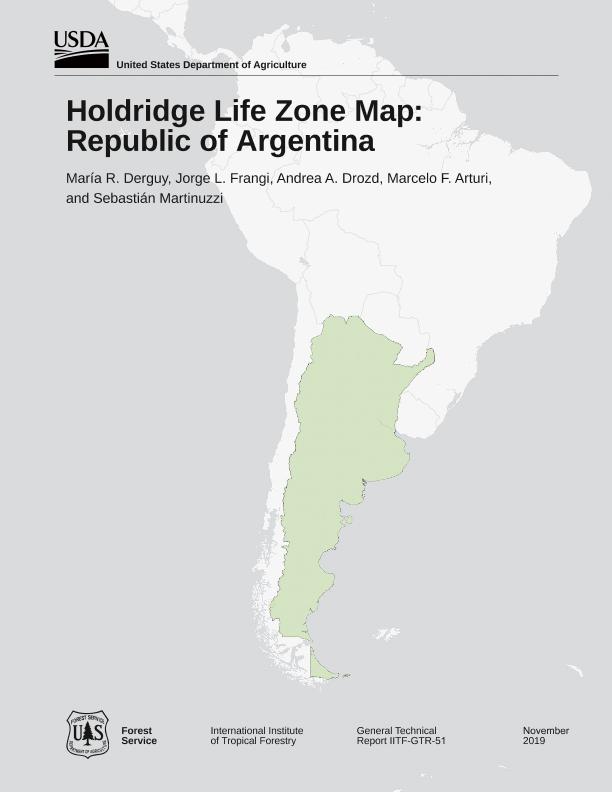Artículo
Holdridge Life Zone Map Republic of Argentina
Derguy, María Rosa ; Frangi, Jorge Luis; Drozd, Andrea Alejandra; Arturi, Marcelo Fabián; Martinuzzi, Sebastián
; Frangi, Jorge Luis; Drozd, Andrea Alejandra; Arturi, Marcelo Fabián; Martinuzzi, Sebastián
 ; Frangi, Jorge Luis; Drozd, Andrea Alejandra; Arturi, Marcelo Fabián; Martinuzzi, Sebastián
; Frangi, Jorge Luis; Drozd, Andrea Alejandra; Arturi, Marcelo Fabián; Martinuzzi, Sebastián
Fecha de publicación:
11/2019
Editorial:
United States Department of Agriculture
Revista:
General Technical Report
ISSN:
0277-5786
Idioma:
Inglés
Tipo de recurso:
Artículo publicado
Clasificación temática:
Resumen
Ecological zonation is a fundamental tool for territorial and ecosystem management. The Holdridge model is a system of ecological zoning based on the identification of bioclimatic units (life zones)that employs the variables of biotemperature, precipitation, potential evapotranspiration (EVT), EVT/P ratio, latitude, and altitude. Argentina displaysa high environmental variability. However, despite the completion of several comprehensive zonationsof intrinsicscientific value, the countrylacksanecological zonation withobjectively and precisely delimitedunits that may be repeated throughtime.The objective of this study was to identify and map the Holdridge life zones present in Argentina. Available climatic data wereintegrated at 1 km spatial resolution.The applied model revealed a highenvironmental heterogeneity, with a total of 83 life zones. Ofthis total, 72 corresponded to life zones in the original triangular model of 120 life zones described by Holdridge,and 11 were new life zones,extending the original model to a total of 131.The model recognized fivelatitudinal regions, from boreal to tropical,and sevenaltitudinal belts, from basal to nival.NorthwestArgentina contained the highest concentration of life zones.The life zones with the most geographic extent are Warm Temperate Dry Forest (15 percent of the nation)and Subtropical Dry Forest (9 percent), while Warm Temperate Alpine Wet Tundra and Subtropical Alpine WetTundra covered less than 0.1 percent.A wide range of biotemperatures, precipitation levels, and elevations,and their diverse combinations, explainwhy so manylife zones are present. Several factors influence climatic systems operating in Argentina,including itsgeographiclocation andnorth-south latitudinal extension (from about 21° to 55° S); the presence and characteristics of different portions of the Cordillera de los Andes (which reach elevations of up to 7000 m above sea level) in the west; the eastern lowlands; and the circumpolar oceanic current and related currents in the southern Pacific and southern AtlanticOceans.Application of the Holdridge system to Argentina resulted in an objective, detailed, and precise country bioclimatic zonation that highlights its environmental heterogeneity,which supports natural ecosystems, cultivated species,agriculture, forestry, and livestock production.This assessment can serve as a useful tool for evaluating the spatial evolution of climate change, land management and other socio-cultural aspects, biodiversity conservation, and other objectives.
Archivos asociados
Licencia
Identificadores
Colecciones
Articulos(SEDE CENTRAL)
Articulos de SEDE CENTRAL
Articulos de SEDE CENTRAL
Citación
Derguy, María Rosa; Frangi, Jorge Luis; Drozd, Andrea Alejandra; Arturi, Marcelo Fabián; Martinuzzi, Sebastián; Holdridge Life Zone Map Republic of Argentina; United States Department of Agriculture; General Technical Report; 51; 11-2019; 1-48
Compartir



